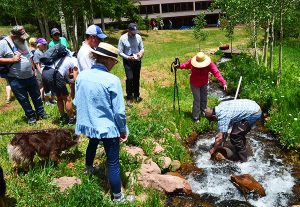by Jennifer Parker
HUERFANO- Who knew that Walsenburg was home to such a jewel of a lady, named Jane Stevenson? Born Jane Stare in 1910 in Waukesha, Wisconsin, she began dancing at age three. She came from a very musical family where most of them sang and/or played musical instruments, but Stevenson found her passion in dance movement. “Our home was always the center of music with people coming in.”
Stevenson had no dance lessons when she started, and because her mother did not believe in ballet dancing for fear that it would ruin her feet, Stevenson entered the world of folk, interpretive, and ballroom dancing. Stevenson said she never even saw ballet dancing until she was 10 years old. “I danced at any and all functions that I could.”
Modern dance originated in Europe, but from 1920 to the 1930’s, America became known as the center for dance experimentation. The dance style actually started as a reaction against ballet. Stevenson was quick to let me know that modern dance differs greatly from ballet. While modern dance is done barefoot with natural movement to the music being played, ballet has definite 5-foot positions, arm and body movements.
Stevenson had her first real lessons in 1933 during summer school workshops at the University of Wisconsin in Madison taught by a remarkable woman named Madge H’Doubler. Stevenson later danced under the direction of such greats as Martha Graham, Doris Humphrey, Hanya Holm, and Jose Limon. Today, New York is home to the Martha Graham Dance Company, the oldest dance company in the world.
Stevenson remembers that modern dance was referred to as interpretive dance in the early years. Once dance became offered as a degree, it became known as modern dance. She earned her degree in Modern Dance around 1935. After college, Stevenson began teaching dance in private and public schools in Waukesha, and around the country. At that time, schools were beginning to introduce creative dance and art areas, whereas previously they might have only offered creative music.
When she was traveling, Stevenson always loved the Indian dancing in Santa Fe, NM. Friends there encouraged her to go to Dallas, TX because no kind of modern dance was offered there at the time. So after earning $400.00 from giving dance lessons, Stevenson was off to start a new business. She found a home that she refers to as her bungalow and it became her dance and art studio as well. She had no business sign above the door, for her business was merely a friend-grown business. She recalls that she was known as the “pioneer of dance in Dallas.”
She began teaching dance to children in the 1940’s and started with only four children. “I would take whoever would come to the door of my little bungalow.” Stevenson’s favorite part of teaching was seeing how “children began to blossom as soon as they would move.”
She had an immigrant friend from Europe who would come and play the piano while the children would recreate the music through movement. She had some disabled children in her classes. One was a blind child whose parents were very pleased that someone would put their child in with a group of other children. Another was a handicapped child that did not have to hold on to the nurse while moving.
Stevenson taught in Dallas for 12 years and by the end of the lessons, she was teaching mothers as well as their children. She recalls charging around $1 for lessons.
After leaving Dallas, Stevenson headed for Germany to teach at an international school. She recalls that after WWII, people were trying to help refugees. She wanted to be a part of this and went to a settlement house where she taught preschool for kids ages three to five years old. The idea was to extend knowledge that they had missed during the war.
I asked her if she spoke German, and she chuckled as she replied, “Badly!” She had warned the kids that she would make mistakes with their language, but said she taught for 2 years and they got along. “I taught the kids and they taught me” she recalls.
She included music and art with the school lessons, but did not teach dance during that time because the country was still trying to recover from the war and nobody could afford to have dance lessons.
Stevenson left Germany and went to New York to visit dance schools. She recalls that “modern dance has opened many avenues such as medicine and therapy.” She also remembers that Harvard Medical School was introducing the “movement of dance” as a way of getting out emotions. “Dance has thrown many people off because they just tend to think of ballet, but dance movement leads to many other things,” she says.
In her late sixties, she moved to Walsenburg. She would help patients in the nursing home move to music. They did not always have music, but she would still show them how to move. She was very pleased to hear of the lovely El Fandango Dance group going on and was just delighted to see it.
Stevenson thought she was retired from teaching lessons, but she met Barbara Stroh (now Overman) and they started a children’s dance workshop. They taught for about a year, but after Stroh moved away, Stevenson did not continue teaching.
Now in a wheelchair after a leg operation, Stevenson said she has never stopped dancing. She now just does her dance movements with her arms every day. Stevenson says she has no favorite part of dance, other than she “likes to see people coming out of their saddles and get moving.”




